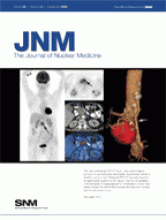Abstract
Incorporation coefficients (K*) of arachidonic acid (AA) in the brain are increased in a rat model of neuroinflammation, as are other markers of AA metabolism. Data also indicate that neuroinflammation contributes to Alzheimer's disease (AD). On the basis of these observations, K* for AA was hypothesized to be elevated in patients with AD. Methods: A total of 8 patients with AD with an average (±SD) Mini-Mental State Examination score of 14.7 ± 8.4 (mean age, 71.7 ± 11.2 y) and 9 controls with a normal Mini-Mental State Examination score (mean age, 68.7 ± 5.6 y) were studied. Each subject received a 15O-water PET scan of regional cerebral blood flow, followed after 15 min by a 1-11C-AA scan of regional K* for AA. Results: In the patients with AD, compared with control subjects, global gray matter K* for AA (corrected or uncorrected for the partial-volume error [PVE]) was significantly elevated, whereas only PVE-uncorrected global cerebral blood flow was reduced significantly (P < 0.05). A false-discovery-rate procedure indicated that PVE-corrected K* for AA was increased in 78 of 90 identified hemispheric gray matter regions. PVE-corrected regional cerebral blood flow, although decreased in 12 regions at P < 0.01 by an unpaired t test, did not survive the false-discovery-rate procedure. The surviving K* increments were widespread in the neocortex but were absent in caudate, pallidum, and thalamic regions. Conclusion: These preliminary results show that K* for AA is widely elevated in the AD brain, particularly in regions reported to have high densities of senile (neuritic) plaques with activated microglia. To the extent that the elevations represent upregulated AA metabolism associated with neuroinflammation, PET with 1-11C-AA could be used to examine neuroinflammation in patients with AD and other brain diseases.
Footnotes
-
COPYRIGHT © 2008 by the Society of Nuclear Medicine, Inc.







